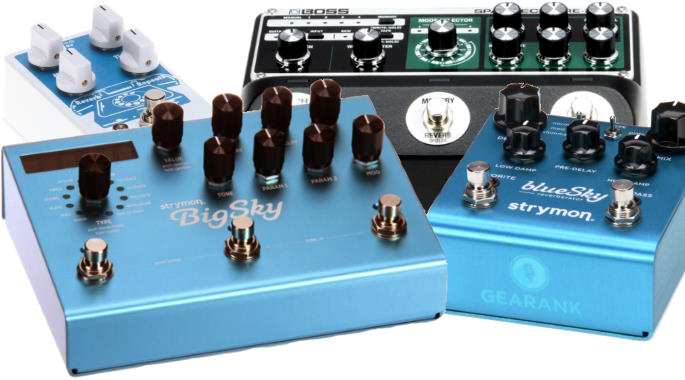
Discover the best delay reverb pedal combos that guitarists love. Learn why they are market favorites and choose one for yourself.
Disclosure
We recommend all products independently of 3rd parties including advertisers. We earn advertising fees from:
• • • • •

• • • • •
Amazon
As an Amazon Associate we earn from qualifying purchases.
• • • • •
More Guitar Pedals
Create complex swells and ambient echoes with the best delay reverb pedals. These 2-in-1 pedals let you benefit from two of the most widely used time-based effects.
Reverb and delay effects are echo manipulations inspired by naturally occurring phenomena. They are often called time-based effects because they are controlled by time parameters, often through a tap tempo feature. These effects were initially used in audio processing and production but were soon adopted by musicians.
Guitarists in particular enjoy using delay and reverb, mostly for adding subtle spatial depth. But there are some guitar players who these effects to create complex sound textures and expansive ambiance.
Note that dedicated reverb pedals and delay pedals generally offer more control over parameters. These include popular pedals from Strymon and Walrus Audio. But why choose between reverb vs delay when you can have both?
The focus of this guide is on reverb delay combo pedals that can simplify your setup and save pedalboard space. Familiar brands like Boss and Keeley Electronics retain their prominent presence in this market, joined by EarthQuaker Devices and Source Audio.
The Best Delay Reverb Pedal Combos 2024
| Gearank* | SRC* | Check Price | ||||||
|---|---|---|---|---|---|---|---|---|
| The Best Delay Reverb Combo Pedals | ||||||||

|
EarthQuaker Devices Dispatch Master V3 | 95 | 250+ | |||||

|
Boss RE-202 Space Echo | 93 | 250+ | |||||

|
EarthQuaker Devices Avalanche Run V2 | 93 | 225+ | |||||

|
Keeley Caverns V2 | 93 | 550+ | |||||

|
Source Audio SA263 Collider | 92 | 275+ | |||||
The Best Delay Reverb Combo Pedals
EarthQuaker Devices Dispatch Master V3 Digital
Cons
- Less tweaking options.
- Reverb features are limited.
- No tap tempo.
Pros
- Lush, beautiful, and exquisite reverb.
- Simple and efficient controls.
- High-quality build.
- Organic sounding delay repeats.
The Dispatch Master V3 is a delay-reverb pedal with a simple set of controls. It features four knobs and a single footswitch.
You can switch between reverb-only mode and delay-only mode. You could also blend both effects simultaneously by adjusting the reverb and repeat knobs.
The V3 includes flexi-switch technology, allowing for silent on-off switching and momentary switching. Its input and output jacks are positioned at the top for convenience.
The reverb section has two dedicated knobs for mix and reverb, providing straightforward control. This removes the need to manage multiple parameters.
The mix knob adjusts the reverb level from basic room to ambient shimmer.
Despite having only two knobs, the reverb sounds dense and natural. This complements the core sound without overpowering the built-in delay. This simplicity makes the Dispatch Master a crowd favorite.
However, it may not be suitable if you seek more control, as features like tap tempo are not included.
The delay section features knobs for adjusting time and repeats. This delivers organic-sounding repeats that blend well with clean or overdriven tones.
The four knobs on the pedal provide effective and essential controls. But the delay has more of a "smearing" effect than full-fidelity repeats, making tap tempo unnecessary.
The pedal's build quality is on par with regular-sized stompboxes. Its top-mounted jacks allow for better pedalboard positioning too.
Overall, the Dispatch Master V3 is an excellent choice if you want an easy-to-use, plug-and-play, multi-function time-based effects pedal.
Specifications
- Reverb: 1 Reverb Algorithm
- Delay: Up to 1.5 Sec Delay
- Controls: Mix, Reverb, Time, Repeats
- Input: 1 x 1/4"
- Output: 1 x 1/4"
- Power: 9V DC Power Supply (Sold Separately)
- Bypass Type: True
- Dimensions (HxWxD): 2.25" x 2.5" x 4.75"
- Weight: 1.1 lbs
| Website | Source | *Rating Value |
| YouTube | ThePedalZone | 96/100 |
| YouTube | Music Bliss Malaysia | 97/100 |
Boss RE-202 Space Echo Pedal
Cons
- Takes up space equivalent to 2 pedals.
- No reverb presets.
- Steep learning curve with the parameters and controls.
Pros
- Nostalgic sound replicates the classic tape echo sound closely.
- Customizable preamp saturation.
- Wow & flutter, saturation, and multiple tape heads.
- Stereo capabilities, tap tempo, presets, modulation/tape age control.
- Durable construction with vintage aesthetics.
The Boss RE-202 Space Echo is a modern recreation of the iconic Roland RE-201 Space Echo. It uses digital modeling and algorithms instead of using actual tape, like old tape delays.
This allows it to recreate the "wow and flutter" of the original, along with other characteristics like preamp flavor, saturation, and spring reverb effects.
It is a vintage-flavored tape delay effect that you can use without unwanted "tape hiss". You also won't have the hassle of maintaining an actual tape machine analog delay unit.
Because of their analog flavor, they can be used to produce a warm-sounding ambiance. For example, the RE-202 can be set up for a fast slapback-style Echo. This is great for rockabilly, country, rock, and similar styles.
The tape delay effect works in conjunction with the built-in spring reverb. It mimics the original but with modern stereo output thanks to its digital delay design. This is the best reverb/delay pedal if you're looking for old school tape delay style sounds.
In addition to the classic spring, other reverb effect types are also available, like hall, plate, room, and ambiance presets. But switching types is more of a hidden feature, so it's not something you can do instantly, which is a bit of a letdown.
The Boss RV 6 is a good alternative if you're looking for a reliable yet more straightfortward reverb/delay combo pedal from Boss.
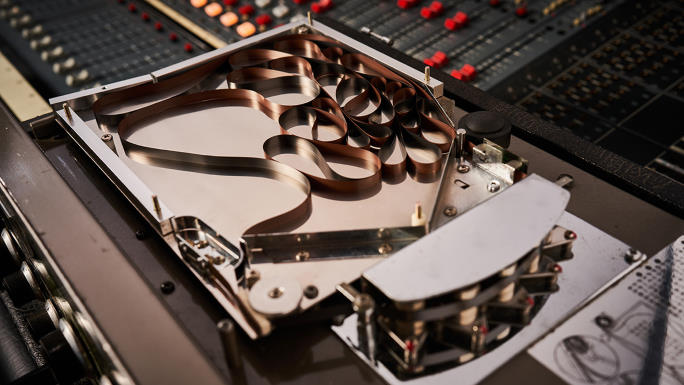
Here's a look at the innards of the original Roland RE-201
Similar to the original Roland RE-201, the RE-202 comes with the iconic 12-position mode selector. This gives you 12 different types of echo rhythms. It also has a Repeat Rate knob, which lets you adjust tape speed, changing the echo pitch as you tweak the knob, behaving like a real tape machine.
The Intensity knob lets you set the number of echoes and can even self-oscillate when set high enough. The Saturation knob lets you add in the analog preamp flavor of the old RE-201.
The Wow & Flutter knob lets you add tape speed variations found within tape machines. As a result, you get a subtly modulated reverb that sounds both musical and organic.
The RE-202 is not a strict clone, as it features enhancements like having a fourth virtual tape head, double the delay time and more.
The Tape button is one of its coolest features, letting you choose between new and old tape sounds. It affects the overall sound quality, tone, and wavering of the echoes.
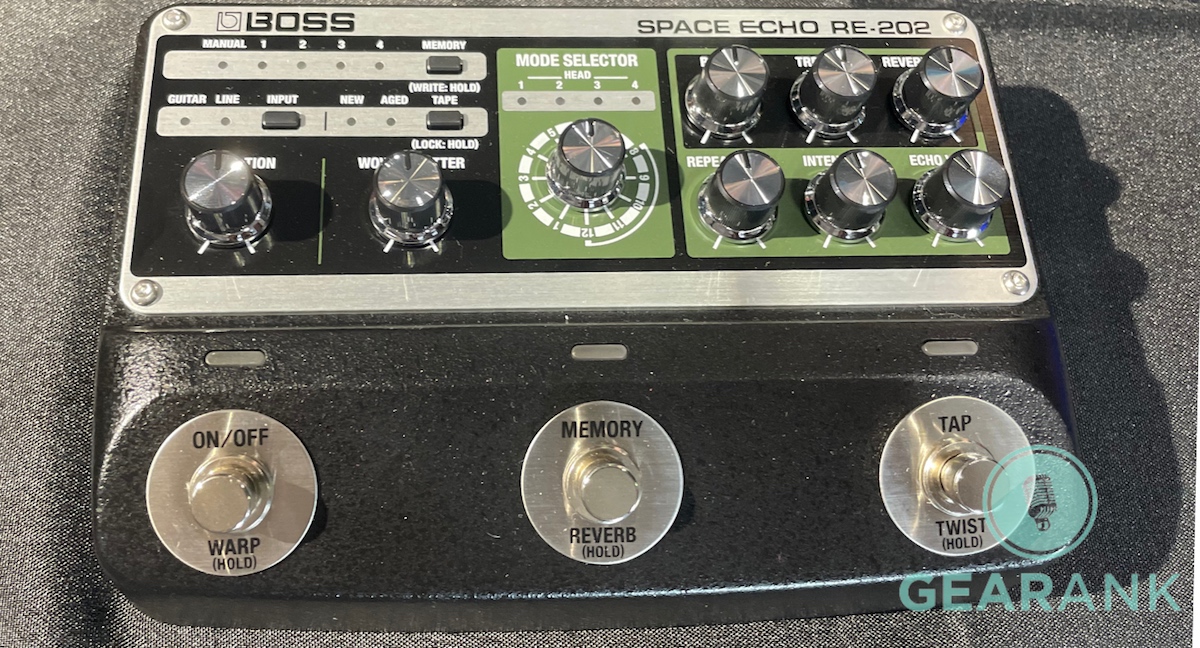
The aged tape setting gets the classic tape echo vibe down nicely, which works great for guitars and other sound sources.
The unit has an input button that switches between guitar and line-level input. Other modern features include preset management (4 onboard memory locations, expandable via MIDI), tap tempo, and switchable delay trail.
Made by Boss, this high-quality pedal is versatile and worth looking at if you're into classic tape delay and reverb effects pedals.
Specifications
- Reverb: 5 Reverb Modes, 12 Tape Modes
- Delay: Up to 2 Sec Delay
- Controls: Saturation, Wow & Flutter, Mode Selector, Bass, Treble, Reverb, Repeat Rate, Intensity, Echo Vol, Memory, Input, Tape, 3 Foot Switches
- Input: 2 x 1/4" (A/mono, B)
- Output: 2 x 1/4" (A/mono, B), 1 x 1/4" (control/expression)
- Power: Power Supply (Included)
- Bypass Type: True
- Dimensions (HxWxD): 2.04" x 7.55" x 5.23"
- Weight: 1.89 lbs
| Website | Source | *Rating Value |
| Sound on Sound | Paul White | 96/100 |
| Guitar World | Trevor Curwen | 90/100 |
| YouTube | Pete Thorn | 95/100 |
EarthQuaker Devices Avalanche Run V2 Stereo Delay and Reverb Pedal
Cons
- Power-hungry, requiring 425mA.
- Wider enclosure.
- Popping switches and loosening input locknuts.
Pros
- Rich and expansive soundscapes.
- User-friendly controls.
- Enhanced stereo output.
- Momentary Footswitch.
- Seamless effect switching.
TThis version of the Avalanche Run includes three key improvements over the original. The enclosure is wider, which might be a plus or minus depending on your pedalboard space.
The stereo output has been enhanced for better sound quality, and the footswitch now allows for momentary use of the effect.
These changes are built on the same control set, sound quality, and graphic design that made the original popular.
The Avalanche Run V2 has rich, expansive soundscapes, especially for clean tones. Its reverb and delay are great for creating ambient effects. It also has an expression pedal output that offers additional control options.
A three-way toggle switch that lets you access three modes: Reverse, Normal, and Swell. Which are the Reverse Delay, Delay and Reverb, and Volume Swell modes.
Its Tails mode lets sound naturally fade out even after turning the effect off. This creates a seamless transition when switching effects while playing.
However, it requires 425mA which is a lot of power, and there can be issues with popping switches and loosening input locknuts too.
But the EarthQuaker Devices Avalanche Run V2 is still a solid choice for a Delay and Reverb Pedal.
Specifications
- Reverb: 1 Reverb Algorithm
- Delay: 1 Delay Algorithm, Up to 2 Sec Delay
- Controls: Time, Repeats, Tone, Mix, Exp, Decay, Mix, Ratio
- Input: 2 x 1/4″
- Output: 2 x 1/4″
- Power: 9V DC Power Supply (Sold Separately)
- Bypass Type: True (Buffered in Trails Mode)
- Dimensions (HxWxD): 3.25″ x 5.25″ x 6.75″
- Weight: 1.12 lbs
| Website | Source | *Rating Value |
| YouTube | The Gear Cage | 96/100 |
Demo
Keeley Caverns V2 Delay and Reverb Pedal
Cons
- Fine adjustments can be challenging.
- No tap tempo.
Pros
- Natural, organic-sounding delay and reverb tones.
- Versatile yet intuitive controls.
- Top-Mounted Input/Output Jacks.
- High-quality DSP.
Keeley Caverns V2 offers three reverb types. Spring, which mimics a vintage Blackface-style reverb with tremolo; Shimmer. It adds an octave-up effect; and Modulation, which mixes in a chorus effect.
These are paired with an analog tape-style delay that gives you up to 650ms of delay time with some nice wow/flutter modulation.
The controls are straightforward, despite having many knobs. It's got four knobs and a switch for each effect. So dialing in your preferred setting is intuitive.
While still impressive, turning the knobs can be quite abrupt. So, dialing in fine adjustments can be quite challenging.
Its top-mounted input/output jacks. This simplifies pedalboard setup and cable management. And regardless of the delay/reverb setting, it doesn't lag or get lost because of its strong DSP.
Overall, the Keeley Caverns V2 is the best delay/reverb pedal when it comes to reliable use of the two effects. It's well-regarded for both ambient and more traditional time-based effect sounds.
You could even try their interactive player on the product page. This way you can hear how the sound changes in real time, with the parameter settings of your desire.
Specifications
- Reverb: 3 Reverb Types: Spring, Shimmer, Modulation
- Delay: Tape-Style with Wow/Flutter modulation
- Controls: 2 x Blend, 2 x Rate, Decay, Time, Warmth, Repeat, 2 x Mode Switches
- Input: 1 x 1/4″
- Output: 1 x 1/4″
- Power: 9V DC 100mA power supply (sold separately)
- Bypass Type: True Bypass (Buffered in Trails mode)
- Dimensions (HxWxD): 3.7″ x 4.7″
- Weight: 1.02 lbs.
| Website | Source | *Rating Value |
| YouTube | Sweetwater | 94/100 |
Demo
Source Audio SA263 Collider Delay+Reverb Pedal
Cons
- Unusual MIDI port placement.
- Steep learning curve.
Pros
- High-quality sound with dedicated DSP for each effect.
- Simple control layout, with access to presets.
- Clear dry signal.
- MIDI functionality.
The Source Audio Collider is built around two 56-bit DSP processors. It has one for each effect, ensuring high-quality sound.
The interface is straightforward, featuring six knobs and a switch for easy parameter adjustment. Users have generally praised the Collider for its sound quality and user-friendly design.
One of the key strengths of the Collider is its versatility. You can store up to 8 user presets directly on the pedal and access up to 120 presets via MIDI program changes.
The Collider delivers clear delays and rich reverbs. It also offers analog dry-through, preserving your dry signal for optimal tone.
It supports both stereo and mono input/output options and is fully MIDI-compatible. But placing the MIDI on the side is quite unusual. The learning curve associated with its deeper functions is quite steep too.
Overall, with its presets and MIDI function, the Source Audio Collider is still a great delay reverb effects pedal, worth checking out.
Specifications
- Reverb: 4 Reverb Algorithms: Spring, Plate, Natural, ’80s Hall, E-Dome, Pitch-Shifting Shimmer, Momentous Swell
- Delay: 5 Delay Algorithms: Tape, Analog, Oil Can, Reverse, Digital
- Controls: Delay, Feedback, Tone, Mix, Control 1, Control 2, Delay/Reverb Type, Delay/Reverb/Lock Switch, Timing Switch
- Input: 2 x 1/4″
- Output: 2 x 1/4″
- Power: 9V DC Power Supply (Included)
- Bypass Type: Switchable (True, Buffered)
- Dimensions (HxWxD): 2″ x 4.5″ x 4.5″
- Weight: 1 lb
| Website | Source | *Rating Value |
| YouTube | Man Bun Metal Head | 95/100 |
Demo
Things to Consider When Buying a Reverb Delay Pedal Combo
-
If you want to add ambiance and space to your guitar sound, then you need Reverb. Delay pedals are for adding rhythmic echoes to your rhythm or lead playing, as popularized by The Edge of U2. Together, reverb vs delay can let you create a wide range of sounds, from subtle and ambient to psychedelic soundscapes. Note that most Guitar Amps come with built-in reverb, but they don't offer the same versatility or quality as pedals. The best reverb and delay pedal combos give you access to the two effects in one unit.
-
Digital Sound Processing and Convolution technology have allowed us to better replicate the ambiance of actual physical rooms. Now we can even modify spatial parameters and even create our own rooms. Below are the most common reverb types along with a feature on special types that don't fall under the four main types.
-
Room
As the name suggests, it replicates the quick sonic bounces of a regular room. It has early reflections and quick decay of no more than a second. Room reverb is the most discrete of the lot, so it is often used for adding subtle warmth and sonic realism.
-
Hall
Hall reverbs are usually based on the actual acoustic space of a large music hall, only digitized for use with your pedal. Since the virtual space is bigger, the decay is usually longer, ranging from 1 to 3 seconds. It is usually employed to give the guitar sound a three dimensional ambience to emphasize certain parts. especially in rock music.
-
Plate
The plate reverb mode found on the best guitar pedals is a digital simulation of an analog plate reverb which was widely used in the past. It works by sending your guitar signal to a virtual metal plate that vibrates to create reflections and echoes that are usually very quick and full. This reverb type tends to be brighter and is commonly used for subtle enhancement.
-
Spring
Like plate mode, the spring reverb mode is a digital emulation of an actual analog reverb unit that is driven by a metal spring. The resulting reflections are fast and decay quickly, while the bass frequencies roll off as the sound decays. This makes the resulting sound brighter than other types. This is the reverb type that most are looking for in a good analog reverb pedal. It is viable for many guitar styles that emphasize the upper frequencies, including surf, country, and blues.
-
Special Reverb Modes
As processing power improves, manufacturers find more ways to produce reverb. This has resulted in special reverb types that go beyond the usual room emulation. There are now Reverse reverbs, which reverse the sound reflection. It works similar to reverse delay, allowing for sci fi ambiance. There is also Reverb with Modulation, which applies modulation effects to the reflections. It's like having dedicated flanger, chorus, or phaser that you can use just on the reverb. Filter reverb types apply sweeping eq filter effects to the reflections. All these special reverb types are ideal for experimental and modern sound ambience. Loading Impulse Responses of popular studios and rooms is another modern way of getting great sounding reverb.
-
-
The general idea is that more control knobs allow for deeper editing and better personalization. But at the cost more complex setup and interface. So for subtle reverb that's always on, you're better off with a reverb pedal with simple controls. The opposite is true if you want more control and options, be it for customizing or for crafting the textures of your sound reflections. Some reverb pedals even have saturator controls for adding warmth to the echoes. Combo delay reverb pedals usually have fewer delay types, so if you want more delay types like ping pong and reverse, you may want to look into standalone delay pedals.
-
Right from the get-go, you can narrow down your choice by establishing a reasonable price range that fits your budget. Take into account that you'll have to invest a bit more if reverb is a primary part of your sound, especially for ambient and experimental guitar styles. There are budget friendly alternatives available, like the Nux Atllantic Reverb Delay.
We know that pedalboard real estate is also an important consideration, so we have provided the dimensions of the pedals above.
Some Vocal Effects Processors come with built-in reverb. These are ideal for singing guitarists who want to gig with fewer gear. The best delay and reverb pedal combos are also space savers, ideal for electric guitar players with limited pedalboard space.
-
Some guitar player tone purists look for true bypass pedals as they totally 'bypass' the pedal's circuitry when the effect is switched off - leaving it just like you're plugged directly into the power amp. However, one thing to be aware of with reverb pedals is true bypass will cut off the reverb decay as soon as you hit that switch. Some people might find this a little jarring. Buffered bypass pedals continue to feed their output actively so the tail end of that huge cathedral sound can continue to sweep over as you're starting to play the next 'dry' part. A number of these pedals can be configured to either true or buffered bypass. Of course, if you're planning to leave your reverb pedal switched on the whole time then it's always being buffered so there's no difference.
Do I need Delay and Reverb Pedals?
Reverb and Delay in the Signal Chain
While there is no strict rule, most musicians employ their time-based effects at the end of the signal chain. This makes sure that you get your processed guitar sound into the delay and reverb effect. It also prevents echoes from being processed by other effects, which can sound muddy.
Another important question is: what comes first, delay or reverb? The most common signal chains have delay pedals first before reverb pedals. This is because delay is often used as a special rhythmic effect and would not sound good if it echoed a guitar sound with a reverb. Reverb effects tend to be the last effect on guitar players' signal chain. But there is no hard rule to follow, so you can experiment with the best reverb/delay combo pedals as you wish. By experimenting, you can also learn more about how reverb and delay interact with other effects. Having a stereo output is also an important consideration for those who don't want to use ABY Switches for multi-amp setups.
Reverb Types
Parameter Controls
Budget and Pedalboard Space
True Bypass vs Buffered
Best Reverb Delay Pedals Selection Methodology
The first edition was published in 2016. The current edition was published on June 3, 2024
For this edition, we dropped the stand alone reverb units, focusing primarily on the best reverb delay pedals. Note that we do not include multi-effect pedals that have extra effects. In the future, we will put up a separate guide for the best reverb pedal (standalone) units.
To make sure that you can readily buy them, we limited our scope to those that were sold by US-based retailers. For this edition, we ended up gathering over 14,200 reviews and ratings for the 31 pedals that were short-listed; see them in the Music Gear Database. All this data was then fed into the Gearank algorithm to produce rating scores out of 100, which we used to narrow down the list to just the best of the best. For more information about our methods, see How Gearank Works.
About the Author and Contributors
Here are the key people and sources involved in this guide's production - click on linked names for information about their music industry backgrounds.
Lead Author & Researcher
Alexander Briones
I have been writing about and researching music gear for many years, all while serving as a music director at my local church. I engage in guitar playing and singer-songwriter stints, in addition to mentoring young musicians and teaching guitar and bass.
Since I mostly play with a band, I usually stick to subtle reverb. But when I need heavy ambience, I utilize emulations of reverb pedals combined with delay. While I'm in the subtle reverb user camp, I am impressed by guitarists who have made reverb pedals a big part of their sound.
Contributors
Jerome Arcon: Co-writer and Product Research.
Jason Horton: Editing and Illustrating.
Media
Main/Top Image: By Gearank.com using photographs of the EarthQuaker Devices Dispatch Master V3, Boss RE-202, Strymon BigSky and Strymon blueSky.
The individual images of delay/reverb pedals were sourced from websites, promotional materials or supporting documentation provided by their respective manufacturers.
The videos above have been embedded in accordance with YouTube's Terms of Service.




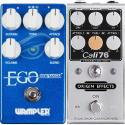
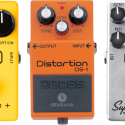
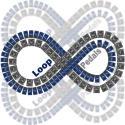
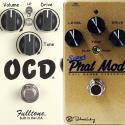
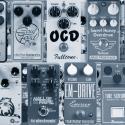
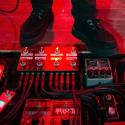
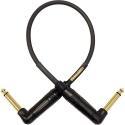
No Source Audio Collider?!
Hi Tom,
The Source Audio Collider was previously featured, but was outranked. You can read more about the Source Audio Collider pedal here.
Publication of our September 2022 Edition resulted in the following pedals coming off our recommended list:
We have removed the Earthquaker Devices Disaster Transport SR due to it being discontinued by the manufacturer.
Our March 2021 update resulted in the following pedals being removed from the recommended list above, but you can still see our analysis of them:
For the updated June 2020 edition, the following came off the recommended list above, but you can still see our analysis of them:
As a result of the October 2018 update, the following reverb pedals were removed from the recommended list above but you can still read our analysis of them here:
What about Fox Pedal’s Wave or Magnifica Deluxe?
We only allow Reverb or Dual Reverb/Delay pedals in this guide and the Foxpedal Wave has reverb, delay and modulation effects making it ineligible.
The Foxpedal Magnifica Deluxe looks promising but we didn’t find the reviews we needed to publish a rating for it so we couldn’t recommend it at this stage, but it’s on the short-list to be considered when we next update this guide.
Today we removed the Boss FRV-1 63 Fender Reverb Pedal from the recommended list above due to a lack of availability. You can still read what we have to say about it at: Boss FRV-1 63 Fender Reverb.
Great roundup! I think the Hall of Fame is superb for the money.